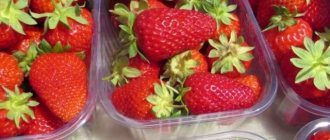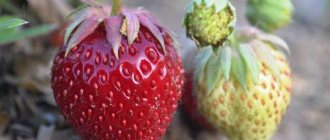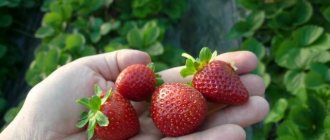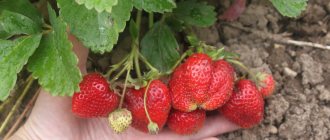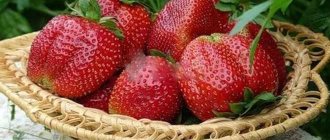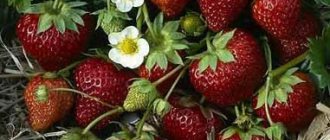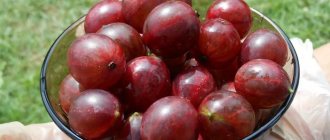Strawberry Marshall has large berries, juicy and sweet. The plant is unpretentious in planting, growing and caring. Resistant to frost and major pests. In this article we will look at ways to plant and care for strawberries.
strawberry variety "Marshal"
for the excellent taste of the berries, the “Marshal” variety is increasing in popularity
Strawberries "Marshal" can safely survive the hottest and rainiest summer
Description of the variety "Marshal"
Strawberry Marshall is a mid-season variety. It fully develops and bears fruit in the cold Russian climate. Adapts well to different weather conditions and soil composition. Able to tolerate drought. In summer, the berry harvest is high. They are larger than average in size, juicy and look presentable.
The variety was brought to our country after the Second World War from the USA, where it was bred by the American breeder M. F. Well at the end of the 19th century.
Features of bushes
Strawberry Marshall grows up to 0.15 m. The plant has the following structure:
- branches branch widely to the sides;
- the stems are thick and dense;
- leaves: large with a light green color; have a glossy shine; the shape resembles an umbrella; grow densely and protect the fruits from excessive sunlight and birds;
- the root is strong with numerous shoots;
- the peduncle consists of dense stems;
- they bear large flowers with a bright center;
- flowers rise above the bush.
The Strawberry Marshall variety is characterized by the growth of numerous mustaches, so the plant is easy to propagate. It is better to trim off excess mustache during active growth and fruiting.
Productivity
A high-yielding variety: in a mild and warm climate and with proper care, more than 800-900 g of berries are harvested from one tuber. In warm climates, fruit harvest almost doubles.
The berry ripening period begins in June and ends in September. Marshall strawberries begin to bear fruit in the first summer after planting, but in each subsequent harvest season the number of berries collected decreases.
It is better to pick strawberries in the afternoon. At this time, there is less excess moisture in it and the shelf life increases.
Berries
Fruit characteristics:
- large size;
- slightly elongated shape with a flattened tip;
- weight from 38 to 65 g;
- the appearance is rich poppy with a slight shimmer;
- solid inside, without voids;
- medium density consistency;
- when cut, the fruit is of a less saturated shade;
- the taste is sweet with a hint of sourness,
- pronounced strawberry aroma;
- The seeds are yellow, small, and almost unnoticeable when eating the berries.
A little history
Marshall strawberries are one of the products of American selection. The author is breeder M.F. Well, who created garden strawberries at the end of the 19th century. Thanks to its amazing taste, the variety quickly gained popularity among Americans, and then began its triumphal march around the world.
Strawberries of the Marshall variety came to Russia half a century later, after the Second World War ended. Russians highly appreciated the variety's ability to adapt to harsh climatic conditions and its ability to produce a stable harvest of unusually tasty berries.
Characteristics of the variety
Experienced amateur gardeners increasingly prefer growing Marshall strawberries due to numerous advantages over other varieties.
Watch the Marshall strawberry review in the video below:
Advantages
The plant has a number of undeniable advantages:
- large berries with a pleasant strawberry taste;
- grows in cold climates;
- easily adapts when planting;
- resistant to weather conditions and dry periods without loss of yield;
- has high yield stability;
- the berries ripen early;
- the harvest period is long;
- undemanding to feeding;
- the berries are protected by wide foliage that shelters from the sun’s rays;
- resistant to diseases and pests.
Strawberries are universal: they are consumed immediately after picking and used for canning and freezing.
Flaws
The plant has some minor disadvantages:
- poor transportability of berries;
- reduction in yield after the first harvest season;
- the formation of a large number of tendrils and the rapid rooting of new tubers.
a brief description of
It’s not for nothing that Marshall strawberries have been popular among gardeners for several decades. She has more advantages than disadvantages.
Advantages of the variety
- consistently high yield with a minimum of care, which can be obtained already in the first year of planting;
- easy adaptation to different climatic conditions;
- Bears fruit for a long time, starting in mid-June;
- good taste;
- versatility of use (fresh, frozen, compotes, jams);
- the plant saves itself from hot rays and from voracious birds;
- Does not require an abundance of fertilizing;
- high drought resistance, even with untimely watering will give a good harvest;
- refers to frost-resistant varieties;
- high immunity to most strawberry diseases.
Disadvantages of the variety
- when transporting fruits, increased caution and special containers are required;
- due to a decrease in yield, a new plantation needs to be established in the second year;
Increased rooting and good rooting of rosettes are both advantages and disadvantages. Strawberries are easy to propagate, but throughout the summer it is necessary to ensure that the tendrils and rosettes do not take away the juices from the fruiting bush.
Planting strawberries
The method of planting Marshall strawberries is the same as for other varieties. The best time is early spring, when weather conditions stabilize. Read about how to plant strawberries in spring in this article.
Some gardeners in warm climates plant strawberries in late fall. But this is not the best way to get a good harvest. There is a possibility of young seedlings freezing in winter, which is the result of insufficient rooting due to the short period of time before winter.
For those who still decide to plant in the autumn, it is worth choosing a time several weeks before the onset of frost so that the plant can better adapt.
Choosing a landing site and soil requirements
Marshall strawberries will grow well if you choose the right planting location. It should be:
- well lit, not obscured by tree crowns;
- It is better to choose a place on the south side of the site, where the sun's rays warm the soil the most;
- with a flat surface, without slopes or lowlands, since during heavy rainfall the accumulation of water must be avoided;
- the area should be ventilated, but strong drafts should be avoided.
Before planting, you need to pay attention to the crops that grew before. Avoid: potatoes, zucchini, cucumbers and tomatoes.
Recommended predecessor crops: onion, garlic, dill, parsley, radish, radish, legumes, carrots, daffodil and others.
Soil requirements:
- Most suitable: slightly acidic, loamy and sandy loam.
- Before planting, it is loosened to achieve lightness and the ability to pass moisture.
- In autumn you need to add organic fertilizers: compost or humus. For loamy soil, add sand, sawdust and ash in addition.
When preparing the soil in the fall, dig it up, remove roots, leaves and branches to avoid the persistence of pathogenic organisms and subsequent infection of strawberry bushes.
Preparation of seedlings
The best time for planting is the first months after winter, then the plant takes root well in the soil and develops. This will allow the strawberries to safely withstand the cold during the winter.
The root system of seedlings must be disinfected before being planted in the ground. Dip the roots into a weak solution of manganese for a few minutes and rinse with clean water.
Planting scheme
The Marshall Strawberry bush is quite large. In summer, the upper part of the plant especially grows and the root system expands. For the full development of the plant, you should adhere to certain planting distances:
- plant seedlings every 1/4 m;
- Leave a space of up to 0.8 m between the beds.
Strawberry bushes can be planted by alternating diagonally, adhering to the normal distance.
Planting strawberries
The procedure for planting seedlings is very simple:
- Dig holes in the ground with a depth equal to the length of the seedling's root.
- Carefully place the plant in the hole, straighten the roots and sprinkle with soil. Root deformation leads to slow development and very small yields.
- After planting, water the plant thoroughly.
- After some time, loosen the soil to allow moisture to reach the roots.
Favorable time for planting is evening and cloudy weather.
Agricultural technology
Growing Marshall strawberries is not difficult, since agrotechnical standards are not much different. Spring plantings are successful. Over the summer, the bushes not only take root, but also produce a good harvest.
The variety is propagated by seeds, rosettes and division of the bush. All three methods are justified. Strawberries are planted with the onset of stable positive temperatures.
Where is the best place to plant
Strawberry Marshall feels good in open sunny ridges and fertile soils. When choosing a place to plant a variety of American selection, you need to take into account the predecessor crops; it is best to plant the variety after:
- radishes, radishes, lettuce and spinach;
- dill, legumes and parsley;
- turnips, carrots and celery:
- onions and garlic;
- tulips, daffodils and marigolds;
- mustard and phacelia.
Many of these crops can also be planted between strawberry bushes.
Comment! But any nightshade plants, as well as cucumbers, are antagonists and suppress the growth and development of garden strawberries.
Seating
Strawberry beds need to be formed especially carefully. Clayey and undrained damp areas are best suited for planting the Marshall variety, as gardeners write in reviews. It is good to create ridges on low hills so that the earth can warm up from all sides. Place the ridges in illuminated areas in the south-north direction.
The soil for strawberries is prepared in the fall. Organic fertilizers are added, such as compost or humus, peat, as well as sand and wood ash. During digging, roots and all plant debris are removed. If phacelia or mustard grew on the site, they are not pulled out, but embedded in the soil.
Planting strawberries
As already noted, Marshall strawberries can be propagated by seeds, root division and rosettes. The seeds are sown in February and the seedlings are grown in the traditional way. Seedlings are planted after positive temperatures have been established.
Strawberries can be propagated by dividing the bush in early spring, and by rosettes as they form. Spring planting allows you to obtain viable and fruit-bearing plants. In addition, such plants build up a powerful root system over the summer and tolerate winter well.
Gardeners can plant bushes:
- in a checkerboard pattern;
- in one line;
- in two lines.
Since strawberries grow a lot, there should be sufficient distance between them.
You need to know this
If a gardener decides to seriously take up a crop like strawberries, you need to remember:
- Strawberries are returned to their old place no earlier than after 3-4 years. The fact is that spores of fungal diseases have high strain activity. In addition, ectoparasites can remain in the soil for a long time.
- You need to be careful with nitrogen-containing fertilizers, as they promote the growth of green mass and sharply reduce the formation of flower stalks. Under no circumstances should you overdo it.
Features of care
In order for the plant to feel good in the garden, and for the berries to be large and juicy, it is worth caring for it properly. Timely harvesting plays an important role in the health and full growth of the strawberry bush.
Overripe berries attract insects and small rodents. They become a favorable environment for the proliferation of bacteria and putrefactive processes.
Watering
The first abundant watering after planting is done in late spring, when active growth begins. Next, water regularly as the soil dries out. Finished after harvesting the last harvest at the end of September.
Watering time: early morning or evening, after sunset. The moisture should be well absorbed. Its evaporation during the daytime can lead to burn damage to stems and leaves.
Water the plant with caution: pour water at the root, avoid getting moisture on the leaves and flowers.
Watering frequency: in moderate climates, once a week is sufficient. In summer and in hot weather, watering is increased 2-3 times.
During dry periods, strawberries are mulched: with hay, sawdust or dry grass to prevent moisture evaporation.
Loosening
Do not allow the soil around the strawberry bush to harden. The access to oxygen and moisture will be noticeably reduced and the plant will begin to wither. To avoid this situation, it is worth periodically, as needed, to loosen the soil.
Fertilizer application
In soil with enough fertilizer before winter, strawberries grow well and can do without additional fertilizing. If the shoots have noticeably become thinner, this means a lack of potassium in the soil. Mineral fertilizer should be added, as well as wood ash.
We recommend reading the article about spring feeding of strawberries.
For preventive purposes, supplements of organic and mineral origin are applied. During the period of active growth in May, during the ripening of berries in June and after the final harvest of berries in September, it is recommended to use fertilizers to replenish the plant's strength.
Fertilizers are applied along with watering and loosening the soil. The following fertilizers are used: mullein, bird droppings, wood ash and weed infusions.
The Marshall strawberry variety is very sensitive to inorganic fertilizers. If the dosage is incorrect, the root system can be severely damaged.
Pros and cons
Experts include the undoubted advantages of the Marshall strawberry variety:
- high and stable yield, especially in the first season after planting;
- seedlings quickly adapt to new conditions, take root well and tolerate temperature fluctuations;
- fairly early ripening of berries, stable long-term fruiting;
- good taste and presentation of ripe berries, versatility of their purpose;
- the foliage is large, it protects ripening fruits from hot sun rays and bird attacks;
- Marshall strawberry bushes do not require special feeding. They are resistant to periods of drought, and the plants do not reduce their yield;
- high frost resistance of Marshall strawberries, which allows this variety to be grown in most Russian regions;
- good immunity, thanks to which the variety is practically not susceptible to disease.
But this strawberry also has disadvantages that you need to remember:
- ripe berries do not tolerate transportation well;
- The yield of Marshall strawberries decreases already in the second season after planting, so you have to plant new rosettes of this variety every year.
On a note!
Many gardeners argue that the excessive formation of whiskers in the Marshall strawberry variety is also a disadvantage, since they have to be regularly removed during the growing season.
Caring for strawberries after harvest
At the beginning of autumn, when the period of active growth and fruiting has ended, strawberries continue to grow. New shoots and leaves appear, root growth does not stop, even false flower buds are formed.
During this period, you cannot completely cut off the bush. It is permissible to prune yellowed and drying leaves. You definitely need to loosen the soil. If pests or disease have damaged the above-ground part of the plant, it is cut off at the root.
When pruning parts of the plant, it is worth leaving about 3 cm of shoots from the root.
You also need:
- remove mulch that may contain pathogens;
- do weeding and get rid of all weeds;
- loosen the soil;
- add fertilizer;
- water generously;
- if necessary, treat with drugs against various pests.
To prepare strawberry bushes for winter, it is worth taking into account the climate zone. In colder regions, you need to cover the plant more thoroughly to avoid freezing of the roots.
Strawberry Marshall: reviews from summer residents
Natalya, 30 years old, Far East: My grandmother was involved in growing strawberries of this variety. Then my mother looked after the strawberries. Currently, we are growing Marshall strawberries together. We grow strawberries for sale, so this variety is quite suitable for us - it is quite productive, the fruits are sweet and very beautiful - buyers snap up our strawberries very quickly.
Olga, 45 years old, Volgograd region: This strawberry appeared on my plot by accident - a neighbor at her dacha was removing her Marshal’s mustache and gave me several shoots. The first harvest from the bushes was amazing - about 0.7 kg from each. I decided to propagate this variety. The appearance, yield, and taste of Marshall strawberries are excellent!
When growing Marshall strawberries, you must take into account the characteristics of the variety and follow all the rules of care.
In this case, the plants will thank the gardeners with abundant fruiting.
Diseases and pests
Strawberry Marshall has good immunity to viral diseases and harmful pests. To prevent diseases, marigolds, aromatic herbs and garlic are planted between the beds.
If a disease occurs, the bushes should be sprayed with a special compound purchased at any specialty store.
Sprayers should not be used during flowering and harvesting. The berries absorb harmful compounds and, once ingested, can cause poisoning.
If infected with a fungus, the plant should be sprayed with a fungicide and all tendrils should be cut off. If necessary, repeat spraying.
If you are infected with a strawberry mite, you need to thoroughly disinfect everything and dig up the soil. The tick is more active in late spring and summer. It is a carrier of dangerous fungal diseases.
It is possible to understand that strawberries are affected by mites by the leaves twisted into a tube only in the middle of summer. At earlier stages it is difficult to detect a tick. It cannot be seen with the naked eye. If you do not disinfect and spray with special preparations, the mite will not disappear on its own, but the plant will turn yellow, decrease in size and may die completely.
Whitefly infestation is one of the most destructive nuisances. First, they, in the form of small insects, settle in the lower part of the bush, as they do not like sunlight. The next development cycle is transformation into a butterfly. She has white wings, which is where the name comes from. Butterflies parasitize the leaves and drink their juice.
Loosening the soil is the best prevention against whiteflies. The adult is disposed of using adhesive yellow plywood sheets placed between the beds.
Pests and diseases
If not properly cared for, the crop may encounter a number of diseases. The main problems that the Marshall may encounter include:
- Gray rot. With this disease, a characteristic gray coating appears on the berries. This plaque causes the fruits to begin to rot. To combat this disease, special fungicides are used.
- Fusarium. Symptoms of this disease are brown spots on the leaves and petioles. If these symptoms were found on a plant, then it must be immediately dug up and burned so that the disease does not spread further to healthy bushes. And the soil where the diseased bush previously grew should be watered with a strong manganese solution.
- Powdery mildew. With this disease, a white coating appears on the leaves. The leaves begin to deform. To treat this disease, you can resort to folk remedies. For example, a good method of combating powdery mildew is a solution of milk and iodine (30 drops of iodine are diluted in 1 liter of milk). You can also use special fungicides.
- Nematode. This is a small worm up to 1 mm in size. The parasite feeds on the juices of the plant, which leads to its death. To combat this parasite, special insecticides are used, which can be purchased at any specialty store.
- Weevil. These are small parasites about 5 mm in length. The pest attacks the flowers and leaves of the crop. They fight the parasite with special insecticides.
- Whitefly. This is a small butterfly with white wings. The butterflies reach 1.5 cm in length and, together with their caterpillars, settle on the back side of the leaf plate. This parasite secretes a sticky substance that leads to the development of fungal diseases. As with other parasites, whiteflies can be controlled with pesticides.
- Strawberry mite. A very common parasite. Its presence on the plant can be identified by a thin web. As a result of the activity of this pest, the leaves of the plant turn yellow and dry out. To combat this parasite, special insecticides are used.
Reviews from gardeners about the variety "Marshal"
★★★★★
Antonina, 39 years old, accountant, Moscow region. I inherited Marshall strawberries from relatives along with the dacha.
And I liked her so much. The berries are large and tasty. It tolerates winter well, although I cover it well. I'm very pleased with these strawberries. ★★★★★
Maria Ivanovna, 59 years old, pensioner, Belgorod. My granddaughter was treated to strawberries by a neighbor.
I tried it too and was pleasantly surprised by their juiciness and delicate aroma. I took seedlings from a neighbor and planted them in the spring. In the summer we were already harvesting together with our granddaughter. Strawberries are so delicious and don't require much care. ★★★★★
Nikolay, 46 years old, truck driver, Samara. I recently took up gardening.
I read a lot of forums and decided on Strawberry Marshall. I don't regret it at all. I planted it in early spring and already in the summer of the first year I collected almost a kilogram from each bush. I will continue to grow only this. Hide
Add your review
Marshall strawberries are easy to grow and care for. The reward for your efforts will be juicy and large berries, which can be frozen if desired. This variety is quite resistant to temperature changes, short droughts and pathogenic pests.
0
0
Copy link
Productivity of the variety
Marshall strawberries begin to bear fruit by mid-June. With good care and favorable climatic conditions, at least 1 kg of ripe produce is harvested from each bush, which is an excellent indicator for a variety bred more than a century ago.
Advice!
This variety shows the highest yield in the first season after planting; later, fruiting decreases. Therefore, experienced gardeners recommend planting new beds with these strawberries every year.
History of origin of the variety
A strawberry seedling, later named “Marshal,” was accidentally discovered in 1890 by Marshall F. Ewell on a ranch in Marshfield Hills, Massachusetts, and was introduced to the public as an independent variety in 1893 . Over the next fifty years, the variety has become a leader in the industrial berry market of the Pacific Northwest, establishing itself as America's most delicious berry.
It is known from open sources that in 1925, Dr. Ulysses Hedrick, who worked in the horticulture department of the New York State Agricultural Experiment Station, gave a botanical description of “Marshal”. In 1966, George M. Darrow—then America's leading authority on strawberries—confirmed that the variety was grown in fields in central and northern California, Sacramento, Oregon, and Washington between 1910 and 1945, primarily for commercial processing , primarily queue for the production of frozen strawberries. In the fields of central and northern California, "Marshal" was grown under the name Banner, and in Sacramento - as Oregon Plum.
Although the berries became soft after defrosting, they retained their taste and deep red color.
Despite the excellent taste and marketability of the fruits, the variety turned out to be too “capricious” : it requires intensive agricultural technology, is prone to late blight, viral and mycoplasma diseases, and pest damage. In addition, it had low transportability and shelf life due to the loose structure of the berry skin. Therefore, since the late 40s of the last century, “Marshal” was replaced with more productive and hardy varieties. But at the same time, thanks to the work of famous American breeders, the plant became the progenitor of a number of valuable varieties of strawberries bred in the USA (for example, “Catskill”).
Since 2004, American experts have included the Marshall variety in the list of “700 food products, animals and plants that are in danger of extinction.”
Manufacturers promote the variety as “ideal, with amazing taste,” but when purchasing planting material, you need to take into account that promising advertising descriptions in practice do not always meet gardeners’ expectations. Productivity and taste, like any other variety of crop, largely depend on the weather and climatic conditions of the growing region and the level of intensity of agricultural technology.
Positive and negative qualities of Marshall strawberries
The variety has been on gardeners' plots for many years. During this time, they managed to highlight a number of its main advantages. The main advantages of this variety include:
- The berries are quite large in size, have an attractive appearance and exude a pleasant aroma, which is why the variety is in great demand on the market.
- The variety can be grown in harsh climatic conditions.
- Marshall easily adapts to various growing conditions.
- Garden strawberries of this variety tolerate short-term droughts quite well, which do not affect the yield.
- The berries ripen quite early.
- Marshal is characterized by long fruiting.
- The variety can bear fruit well even in the absence of fertilizing.
- Marshall has a strong immune system, which protects him from a number of strawberry diseases, in particular from various rots.
- Berries have a universal purpose. They are suitable for fresh consumption, for making compote, jam, etc.
Beef tripe - what is it and how to prepare it at home according to recipes with photos.
At the same time, we should not forget about the disadvantages of this variety. The main disadvantages of Marshall include:
- The berries have a fairly short shelf life and poor transportability, since they have a rather soft structure.
- Marshall's yield is declining every year.
- The bushes form a large number of tendrils, which complicates the care of the crop.
Growing and care
There are no difficulties in the agricultural technology of growing the Marshall variety. This is why this culture attracts gardeners.
Watering
The variety is drought-resistant and will tolerate prolonged drought. It will respond with gratitude to regular watering. The first watering is carried out immediately after planting. The plant especially needs moisture at the very beginning of the growing season. The soil is kept moist until September.
Loosening, weed control
If no mulching material was used after planting, the beds must be loosened at least once a week. Loose soil perfectly allows moisture to pass through and allows the root system to “breathe” freely. During loosening, weeds are simultaneously removed.
Removing a mustache
Marshall is unusually generous with his mustache. During the summer, shoots not intended for reproduction, as well as dried leaves, are regularly pruned. If you neglect this procedure, there will be no maximum yield.
Feeding
The best types of fertilizers for Marshall strawberries are the following infusions:
Strawberries should be fed immediately after the snow cover melts, before flowering, before the fruit begins to ripen and immediately after harvesting.
It is advisable to combine this event with watering and loosening. When the shoots are very weak, you can add a solution of wood ash. An excellent solution would be to use foliar fertilizers.
Spring fertilizing should be based on nitrogen fertilizers, which stimulate the growth of green mass. In summer and autumn it is better to use potassium-phosphorus compounds.
Prevention and control of pests and diseases
Marshall strawberries have a high immunity, but the plant should be helped to successfully resist diseases and pests. The most environmentally friendly and simplest way is to plant calendula flowers or marigolds between the bushes, sow dill or fennel. In early spring, if fungal diseases are suspected, the bushes are treated with a 3% solution of Bordeaux mixture.
All chemical fertilizing and drug treatments should be stopped a month before the fruits ripen.
Preparing for winter
After the strawberries have given their harvest, it is necessary to cut off the old leaves. They do this very carefully so as not to touch the flower stalks. Leave the stumps at a level of 3-4 cm from the ground. In regions with harsh winters, strawberries are covered with a thick layer of mulching material.
Description
The strawberry variety Marshall of American selection belongs to plants with medium-early ripening periods. It is recommended to grow in any region of Russia; only in the zone of risky farming will it be necessary to cover the plantings.
Features of bushes
- The Marshall variety is a plant with a powerful and spreading structure. The height of the bush is about 15 cm.
- The root system is strong.
- Stems are erect and thick. Strawberries have many large light green leaves that look like umbrellas. The berries are protected from the rays of the scorching sun and from feathered sweet lovers.
- Strawberries, according to descriptions and reviews from gardeners, are distinguished by thick peduncles with an abundance of large white flowers with bright yellow hearts. They rise slightly above the leaves. As the berries fill, the flower stalks bend to the ground.
- Each strawberry bush produces a large number of runners over the summer, so there are no problems during reproduction.
Berries
Marshall strawberry fruits are large, weighing from 40 to 60 grams. Although there have been record holders of greater mass. The berries are shiny, scarlet in color. The variety has an interesting shape, by which it is identified: the fruit has a wedge-shaped top with a small nose pressed into the middle.
Marshall strawberries are medium-density, sweet, with a low acid content. When cut, the flesh is light red, there are no internal cavities or voids. The fruits are juicy and have a bright strawberry aroma. The achenes are yellow (they are clearly visible in the photo), depressed, and cannot be felt when eaten.
As gardeners note in reviews, the Marshall strawberry variety begins to ripen in June. One bush, when favorable conditions are created, produces almost a kilogram of fruit.
Landing Features
Planting time depends on the choice of planting material. If you purchase “Marshal” seedlings from a nursery or garden center, it is better to replant them in the spring (from the end of April to the end of May). In the spring, bushes grown independently from seeds are also moved into open ground. When propagating strawberries by dividing a bush or with a mustache, planting is carried out in the autumn (from early August to mid-September).
When choosing a place for strawberries, you should give preference to high and sunny areas. In low-lying and marshy areas, the situation can be overcome with the help of high embankment beds. Good predecessors for the crop are perennial grasses, legumes, and green manure plants. The soil must meet the following requirements:
- have a light and loose structure;
- absorbs and retains moisture well;
- acidity should be neutral;
- contain nutrients in an easily digestible form.
In areas that are too heavy and clayey, coarse river sand is added to the soil to loosen it. You can increase the moisture capacity of sandy soils using sawdust and humus. The acidity of the soil must be normalized three to four weeks before planting by adding lime or dolomite flour. Fertilize the soil in the autumn. By spring, all substances will dissolve well and will be easily accessible and safe for strawberries. If you apply fertilizer immediately before planting, this can lead to the death of the plants.
Design of beds and placement scheme
Before forming ridges, the soil is dug well, freed from weeds and filled with fertilizers. The prepared beds are left to rest for two to three weeks so that the soil settles thoroughly.
For powerful “Marshal” bushes, the beds are made at least 80 cm wide, in which case the strawberries will be arranged freely in two rows. A distance of 30 cm is maintained between the bushes. Such beds are easy to care for, and the plants will receive the necessary amount of light and oxygen.
For bushes of this variety, a single-line planting scheme is also allowed. With this option, strawberries are planted in one row with an interval of 20-25 cm. The next row is located at a distance of 60-70 cm from the previous one. With this placement, the bushes are well lit and well ventilated.
You should know! In order to save space on the site, it is impossible to overly thicken the strawberry plantings; the plants will suffer from a lack of nutrition and light.
Boarding order
Strawberries are planted in cloudy weather or in the evening. This will help prevent sunburn on the tender leaves of the plants.
Holes are marked on settled beds according to the chosen planting pattern. To ensure that the rows are even, pegs and twine are used for marking. The holes are dug 15-20 cm deep, about 20 cm wide and watered abundantly. In order for strawberries to take root faster, experienced gardeners practice planting seedlings “in the mud.”
Berry bushes are placed in holes in a vertical position and the roots are carefully straightened. The holes are gradually covered with earth. At the same time, it is important to ensure that the heart of the bushes is not buried, but remains on the surface of the soil.
Reproduction
It is possible to propagate the Marshall strawberry variety in three ways:
- Seeds. Seeds are sown in February.
- Usami. Rosettes take root very well, so this propagation method is used most often. The plant produces a large number of tendrils. Bushes intended for propagation are marked in advance. Peduncles are cut off. All the attention of the mother plant should be directed to the rosettes.
- Dividing the bush. This method is suitable for early spring. With this method of propagation, the harvest from young plantings can be obtained already in the current season.
Main characteristics
“Marshal” has not received official registration in the State Register of the Russian Federation, and there is also no reliable data on its licensing and certification in foreign sources. From advertising descriptions and reviews from gardeners in different countries, the most significant characteristics of the variety can be identified:
| Parameter | Characteristic |
| Culture | Strawberry (Fragaria ananassa) |
| Ripening time | Average |
| Fruiting | One-time (non-repairable) |
| Photoperiodic type | Short daylight hours (SDD) |
| Productivity | Moderate: up to 1 kg per bush |
| Mass of berries | On average - 30 g, maximum - up to 50-80 g |
| Fruit shape | Round-cone-shaped with a depressed apex |
| Berry color | Bright red with a glossy sheen |
| Pulp | Red (lighter), juicy |
| Tasting assessment | 4.5-4.8 points (out of 5) |
| Purpose | Universal |
| Educational ability | High |
| Sustainability | Good winter hardiness, heat and drought resistance; slightly affected by gray fruit rot, powdery mildew and verticillium; susceptible to late blight, viral and fungal diseases (brown and white spots) and damage by strawberry mites |
| Productive life cycle | 3-4 years (with a high level of agricultural technology up to 6-8 years) |
| Registration in the State Register of the Russian Federation | Turned off |
According to professional farmers and summer residents who cultivate the variety, the important advantages of “Marshal” are :
- attractive presentation and taste of berries;
- adaptability to open ground conditions in regions with a continental climate, as well as high results when growing off-season products in greenhouses (in soil or on a substrate).
High commercial quality and large size of berries make harvesting easier
In Russia and other post-Soviet countries, many foreign and domestic nurseries and agricultural firms are engaged in the sale of Marshall strawberry planting material.
Advantages and disadvantages of strawberries
Both experienced and novice gardeners note the following positive characteristics of the Marshall variety:
- high taste qualities;
- large fruit;
- excellent yield indicators;
- long fruiting period;
- friendly ripening of fruits;
- sufficient resistance to adverse environmental factors;
- good survival rate;
- universal purpose of fruits;
- increased immunity to major ailments;
- frost resistance;
- drought resistance;
- high ability to form a mustache;
- there is no need for additional feeding.
See also
Description and characteristics of strawberries of the Divnaya variety, planting scheme and careRead
But, despite the whole list of advantages, Marshall strawberries also have some disadvantages:
- low degree of transportability;
- decrease in yield in the second year after planting;
- the need for regular removal of antennae.
Taking into account the strengths and weaknesses of the berry crop, it is possible to harvest the richest possible harvest.
Preparing for the winter season
Despite the fact that frost-resistant Marshall strawberry bushes do not require insulation in the winter, preparation for wintering should be carried out without fail. First of all, inspect the berry beds and remove all damaged or diseased plants. In healthy bushes, dried and old leaf blades are cut off, as well as all remaining peduncles and shoots.
During the summer season, due to heavy rainfall and partial subsidence of the soil, strawberry roots are often exposed. To prevent the root system from being caught by frost, the bushes are lightly hilled. If a lot of plants with bare roots are found, it is best to add a layer of soil to the entire bed at once.
Harvest and storage
Strawberries are harvested as they ripen in the morning or evening. To keep the berries longer, you need to pick them with their tails and put them in wooden boxes, the bottom of which is previously covered with sheets of paper. Whole and undamaged berries should be picked, and rotten specimens should be discarded immediately. At home, it is better to store a small amount of strawberries in a glass jar on the refrigerator shelf. Recommended temperature for storage is +2…0°C. In this way, strawberries can be stored for 3-4 days. The berries are good to consume fresh, but they are also suitable for processing. They make excellent preserves, marmalade, compote, and confiture.
Did you know? If an adult does not have allergies or other contraindications to consuming strawberries, then he can consume up to 600 g per day.
Marshall strawberries are hardy under unfavorable climatic conditions and produce good yields of tasty berries. It is unpretentious in care, but attention should be paid to protective measures against pests and diseases, and numerous whiskers should be removed in a timely manner.
